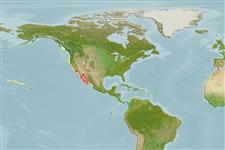Environment: milieu / climate zone / depth range / distribution range
Ecología
marino demersal; rango de profundidad 18 - 347 m (Ref. 9330). Subtropical; - 22°N
Eastern Pacific: Manhattan Beach in southern California, USA to Gulf of California.
Tamaño / Peso / Age
Maturity: Lm ? range ? - ? cm
Max length : 22.0 cm TL macho / no sexado; (Ref. 9330)
Short description
Claves de identificación | Morfología | Morfometría
Radios blandos dorsales (total) : 76 - 93; Radios blandos anales: 63 - 72; Vértebra: 36 - 38. Pectoral fin on ocular side with 10-12 rays, blind side with 9-10 rays (Ref. 35997).
Lives on sandy bottoms.
Life cycle and mating behavior
Madurez | Reproducción | Puesta | Huevos | Fecundidad | Larva
Distinct pairing (Ref. 205).
Eschmeyer, W.N., E.S. Herald and H. Hammann, 1983. A field guide to Pacific coast fishes of North America. Boston (MA, USA): Houghton Mifflin Company. xii+336 p. (Ref. 2850)
IUCN Red List Status (Ref. 130435: Version 2024-2)
Threat to humans
Harmless
Human uses
Pesquerías: escaso valor comercial
Herramientas
Special reports
Download XML
Fuentes de Internet
Estimates based on models
Preferred temperature (Ref.
123201): 8.8 - 18.5, mean 14.6 °C (based on 36 cells).
Phylogenetic diversity index (Ref.
82804): PD
50 = 0.5000 [Uniqueness, from 0.5 = low to 2.0 = high].
Bayesian length-weight: a=0.00724 (0.00401 - 0.01308), b=3.21 (3.05 - 3.37), in cm total length, based on LWR estimates for this species & Genus-body shape (Ref.
93245).
Nivel trófico (Ref.
69278): 3.5 ±0.5 se; based on size and trophs of closest relatives
Generation time: 1.2 ( na - na) years. Estimated as median ln(3)/K based on 1
growth studies.
Resiliencia (Ref.
120179): Alto, población duplicada en un tiempo mínimo inferior a 15 meses (Preliminary K or Fecundity.).
Fishing Vulnerability (Ref.
59153): Low vulnerability (16 of 100).
